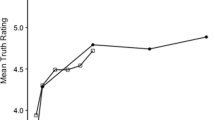Abstract
The present paper investigated the effects of the familiarity between the detector and deceiver and the amount of information available on the detection of deception. It was hypothesized that limiting the amount of information available to the lie detector would increase detection accuracy when the deceiver was familiar and, alternatively, would decrease accuracy when the deceiver was unfamiliar. In Study 1, participants attempted to detect the deceptions of familiar and unfamiliar persons with and without visual cues. The results supported the hypothesis. The deceptions of familiar persons were more likely to be detected when visual cues were withheld and the deceptions of strangers were more likely to be detected when visual cues were not withheld. In Study 2 procedures similar to Study 1 were used. However, in Study 2 the presence or absence of auditory cues was manipulated instead of manipulating the presence or absence of visual cues. The results of Study 2 replicated those of Study 1.
Similar content being viewed by others
References
Bauchner, J. E., Brandt, D. R., & Miller, G. (1977). The truth/deception attribution: Effects of varying levels of information availability. In B. D. Ruben (Ed.),Communication Yearbook 1 (pp. 229–243). New Brunswick, NJ: Transaction Books.
Bond, C., Kahler, K., & Paolicelli, L. (1985). The miscommunication of deception: An adaptive perspective.Journal of Experimental Social Psychology, 21, 331–345.
Brandt, D. R., Miller, G., & Hocking, J. (1980). The truth-deception attribution: Effects of familiarity on the ability of observers to detect deception.Human Communication Research, 6, 99–110.
Buller, D. B., & Aune, R. K. (1987). Nonverbal cues to deception among intimates, friends, and strangers.Journal of Nonverbal Behavior, 11, 269–290.
Buller, D. B., Strzyzewski, K. D., & Comstock, J. (1991). Interpersonal deception: I. Deceivers' reactions to receivers' suspicions and probing.Communication Monographs, 58, 1–24.
Buller, D. B., Strzyzewski, K. D., & Hunsaker, F. (1991). Interpersonal deception: II. The inferiority of conversational participants as deception detectors.Communication Monographs, 58, 25–40.
DePaulo, P. J. (1988). Research on deception in marketing communications: Its relevance to the study of nonverbal behavior.Journal of Nonverbal Behavior, 12, 253–273.
DePaulo, P. J., & DePaulo, B. M. (1989). Can deception by salespersons and customers be detected through nonverbal behavioral cues?Journal of Applied Social Psychology, 19, 1552–1577.
DePaulo, B. M., Stone, J. I., & Lassiter, G. D. (1985). Deceiving and detecting deceit. In B. R. Schlenker (Ed.),The self and social Life (pp. 323–370). New York: McGraw-Hill.
deTurck, M. A., & Miller, G. R. (1990). Training observers to detect deception: Effects of self-monitoring and rehearsal.Human Communication Research, 16, 603–620.
Ekman, P. (1985).Telling lies: Cues to deceit in the marketplace, marriage, and politics. New York: W. W. Norton.
Ekman, P., & Friesen, W. (1974). Detecting deception from the body or face.Journal of Personality and Social Psychology, 29, 288–298.
Ekman, P., & O'Sullivan, M. (1991). Who can catch a liar?American Psychologist, 46, 913–920.
Fiedler, K., & Walka, I. (1993). Training lie detectors to use nonverbal cues instead of global heuristics.Human Communication Research, 20, 199–223.
Hocking, J., Bauchner, J., Kaminski, E., & Miller, G. (1979). Detecting deceptive communication form verbal, visual, and paralinguistic cues.Human Communication Research, 6, 33–46.
Kraut, R. (1980). Humans as lie-detectors: Some second thoughts.Journal of Communication, 30, 209–216.
McCornack, S. A., & Levine, T. (1990). When lovers become leery: The relationship between suspicion and accuracy in detecting deception.Communication Monographs, 57, 219–230.
McCornack, S. A., & Parks, M. R. (1986). Deception detection and relationship development: The other side of trust. In M. L. McLaughlin (Ed.),Communication Yearbook 9 (pp. 337–389). Beverly Hills, CA; Sage.
McCornack, S. A., & Parks, M. R. (1990). What women know that men don't: Sex differences in determining the truth behind deceptive messages.Journal of Social and Personal Relationships, 7, 107–118.
Metts, S. (1989). An exploratory investigation of deception in close relationships.Journal of Social and Personal Relationships, 6, 159–160.
Millar, K. U., & Tesser, A. (1987). Deceptive behavior in social relationships: A consequence of violated expectations.Journal of Psychology, 122, 263–273.
Miller, G. R., Mongeau, P. A., & Sleight, C. (1986). Fudging with friends and lying to lovers: Deceptive communication in personal relationships.Journal of Social and Personal Relationships, 3, 495–512.
Miller, G. R., & Stiff, J. (1993).Deceptive communication. Newbury Park: Sage Publications.
Snyder, M. (1974). Self-monitoring of expressive behavior.Journal of Personality and Social Psychology, 30, 526–537.
Stiff, J., Kim, H., & Ramesh, C. (1992). Truth biases and aroused suspicion in relational deception.Communication Research, 19, 326–345.
Stiff, J., & Miller, G., (1986). “Come to think of it ...” Interrogative probes, deceptive communication, and deception detection.Human Communication Research, 12, 339–357.
Toris, C., & DePaulo, B. M. (1985). Effects of actual deception and suspiciousness of deception on interpersonal perceptions.Journal of Personality and Social Psychology, 47, 1063–1073.
Tversky, A., & Kahneman, D. (1974). Judgment under uncertainty: Heuristics and biases.Science, 185, 1124–1130.
Tversky, A., & Kahneman, D. (1983). Extensional versus intuitive reasoning: The conjunction fallacy in probability judgment.Psychological Review, 90, 293–315.
Wagner, H. L., & Smith, J. (1991). Facial expression in the presence of friends and strangers.Journal of Nonverbal Behavior, 15, 201–214.
Zuckerman, M., DePaulo, B. M., & Rosenthal, R. (1981). Verbal and nonverbal communication of deception. In L. Berkowitz (Ed.),Advances in experimental social psychology (Vol. 14, pp. 1–59). New York: Academic Press.
Zuckerman, M., & Driver, R. E. (1985). Telling lies: Verbal and nonverbal correlates of deception. In A. W. Siegman and S. Feldstein (Eds.),Multichannel integrations of nonverbal behavior (pp. 129–147). Hillsdale, NJ: Erlbaum.
Zuckerman, M., Koestner, R., & Alton, A. O. (1984). Learning to detect deception.Journal of Personality and Social Psychology, 46, 519–528.
Zuckerman, M., Koestner, R., & Colella, M. J. (1985). Learning to detect deception from three communication channels.Journal of Nonverbal Behavior, 9, 188–194.
Zuckerman, M., Spiegel, N. H., DePaulo, B. M., & Rosenthal, R. (1982). Nonverbal strategies for decoding deception.Journal of Nonverbal Behavior, 6, 171–187.
Author information
Authors and Affiliations
Rights and permissions
About this article
Cite this article
Millar, M., Millar, K. Detection of deception in familiar and unfamiliar persons: The effects of information restriction. J Nonverbal Behav 19, 69–84 (1995). https://doi.org/10.1007/BF02173167
Issue Date:
DOI: https://doi.org/10.1007/BF02173167



